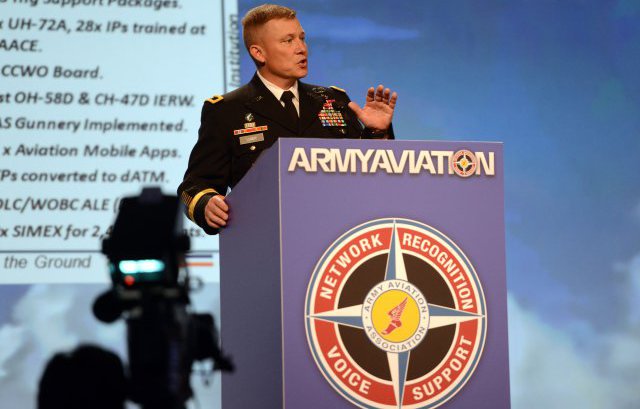The US Army aviation chief, Maj. Gen. Michael Lundy, wants to spend the service’s shrunken aircraft acquisition budget — down about 40 percent over the past three years — on manned rather than unmanned aircraft. After all, this is the Army.
“We’ve got a lot of unmanned stuff out there,” Lundy told an Association of the United States Army conference on aviation, responding to a question from the audience asking what Unmanned Aerial Systems (UAS) the Army needs and whether it could use a drone tailored to carry cargo — something the Marine Corps tested in Afghanistan. Lundy quickly shot the latter idea down as too narrow a mission.
“The demand’s just not there,” he said. “Are there missions where we could use it? Yes. But would I give up manned aircraft to do it? No. I can’t have an unmanned cargo aircraft moving soldiers. We don’t have all the manned structure right now to do all the missions.”
In a hallway interview with Breaking Defense, Lundy added that, in his view, the Army has enough drones of all kinds for the moment. The service is still completing its original buy of MQ-1C Gray Eagles, a derivative of the Predator that carries sensors and up to four AGM-114 Hellfire missiles. The Army also plans to buy 36 improved versions of that General Atomics Aeronautical Systems Inc. aircraft to enable it to contribute 16 daily intelligence, surveillance and reconnaissance Combat Air Patrols to Central Command and other joint commands. The Army also flies a wide range of smaller drones.
“We’ve got thousands of UAS,” Lundy told BD. “We’ve got more unmanned systems than anybody else does in the world. You get too big and you start taking away from manned platforms” He added: “What we have to do is make sure the force is tailored properly. Unmanned systems clearly have a role. They’re a great enabling capability. But there are some missions right now that manned platforms are better at. If we’re going to move troops, we’re going to use soldiers to move troops. We’re not going to put soldiers in the back of unmanned aircraft. If we’re going to put soldiers in the back and fly them into harm’s way, we’re going to have soldiers flying them. Twenty or 30 years from now, who knows what that balance point’s going to be. But that balance point in the next 10 to 15 years, I think we’ve got the number of unmanned systems and the capabilities right.”
In his conference remarks, Lundy said that when the Army does buy or develop new drones, a key requirement should be the ability to take off and land without a runway.
“I don’t want to be on runways anymore” Lundy said. A future drone in the same class as the Gray Eagle, he said, “needs to have a VTOL capability. We’ve got to be able to push it forward with units. It can’t be sitting at an airfield four hours away.” He also listed two other key requirements: “It’s got to be survivable, so we’ve go to reduce the signature. And we’ve got to reduce how many people it takes to run it.” A future Gray Eagle replacement, he added, would need to carry similar payloads and have similar range. “I’m not real concerned about the speed,” Lundy said. “Those are the key requirements – both for our large UAS and for our tactical.”
Source: Breaking Defense

